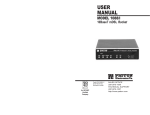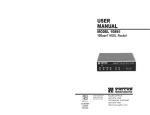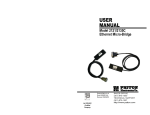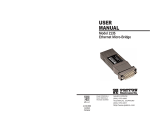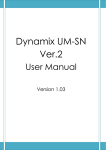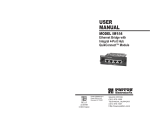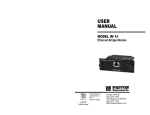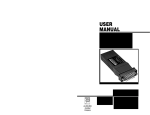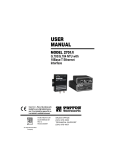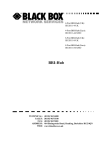Download Black Box MDS920C-10BT Specifications
Transcript
MDU9705A-10BT August 2000 Compact mDSL Modem © Copyright 2000. Black Box Catalogue, Ltd. 464 Basingstoke Road, Reading, Berkshire RG2 0QN TECHNICAL: SALES: FAX: ADDRESS: WEB: (0118) 965 6000 (0118) 965 5100 (0118) 965 5001 464 Basingstoke Road, Reading, Berkshire RG2 0QN www.blackbox.co.uk Compact mDSL Modem Compact mDSL Modem Table of Contents Section Page Radio and TV Interference.....................................................2 CE Notice...............................................................................2 General Information...............................................................3 Features Description PPP Operational Background..............................................4 Configuration .......................................................................6 Plug-and-Play Configuring the Hardware DIP Switches Configuration DIP Switch Set “S2” Configuration DIP Switch Set “S3” Installation ...........................................................................12 Connecting DSL Interface Connecting 10BaseT Ethernet Port to PC (DTE) Connecting 10BaseT Ethernet Port to Hub (DCE) Power Connection Operation.............................................................................15 Power-Up LED Status Monitors LED Descriptions Table Test Modes Radio and TV Interference The Compact mDSL Modem generates and uses radio frequency energy, and if not installed and used properly—that is, in strict accordance with the manufacturer's instructions—may cause interference to radio and television reception. The Compact mDSL Modem has been tested and found to comply with the limits for a Class A computing device in accordance with the specifications in Subpart J of Part 15 of FCC rules, which are designed to provide reasonable protection from such interference in a commercial installation. However, there is no guarantee that interference will not occur in a particular installation. If the Compact mDSL Modem does cause interference to radio or television reception, which can be determined by disconnecting the unit, the user is encouraged to try to correct the interference by one or more of the following measures: moving the computing equipment away from the receiver, re-orienting the receiving antenna and/or plugging the receiving equipment into a different AC outlet (such that the computing equipment and receiver are on different branches). CE Notice The CE symbol on your Black Box equipment indicates that it is in compliance with the Electromagnetic Compatibility (EMC) directive and the Low Voltage Directive (LVD) of the European Union (EU). A Certificate of Compliance is available by contacting Technical Support. Appendix A - Specifications........................................................21 Appendix B - Transmission Distance Chart................................22 Black Box Contact Information....................................................23 1 2 Compact mDSL Modem General Information Thank you for your purchase of this Black Box product. This product has been thoroughly inspected and tested and is warranted for One Year parts and labor. Features • Provides MAC Level Data Link (Layer 2) connection between two peered 10BaseT Ethernet LANs • Operates transparently to higher level protocols such as TCP/IP, DECnet, NETBIOS and IPX • PPP (Point to Point Protocol, RFC 1661) with Bridge Control Protocol (RFC 1638) • Automatically learns, loads and removes MAC addresses • Point-to-Point Connectivity over 2-Wire mDSL up to 10km • Plug-and-Play Slave • HTTP/SNMP Manageable as CP (Customer Premises) Unit with mDSL CO (Central Office) Rack Card • Internal or receive recovered clocking between units • LED indicators for 10BaseT Link, DSL Link, Status, No Signal, Error and Test Mode Description The Compact 10BaseT mDSL Modem is a Multi-Rate DSL Modem that provides seamless MAC Layer connectivity between 2 peered 10BaseT LANs. Now, Enterprise users no longer need to hassle with a bridge and a CSU/DSU or recurring leased line costs. The Compact mDSL Modem allows users to add additional nodes to a LAN that has reached its maximum distance limits or separate high traffic areas of a LAN. The Compact mDSL Modem connects peered LANs and automatically forwards and receives LAN broadcasts, multicasts and frames across a 2-Wire DSL span. The Compact mDSL Modem supports PPP (RFC 1661) and BCP (RFC 1638). The Compact 10BaseT mDSL Modem features include loopback diagnostics, inband SNMP/HTTP remote management capabilities using Plug-andPlay and externally accessible configuration switches. As a symmetric DSL modem, the Compact mDSL Modem offers the same data rates in both directions over a single pair of regular telephone lines using Carrierless Amplitude and Phase (CAP) modulation. The Compact mDSL Modem connects to the DSL line via an RJ-45 jack. Standard power options include 115VAC, 230VAC, Universal (115/230VAC) and any DC input between 36-60VDC. 3 Compact mDSL Modem PPP Operational Background PPP is a protocol used for multi-plexed transport over a point-to-point link. PPP operates on all full duplex media, and is a symmetric peer-to-peer protocol, which can be broken into three main components: 1. A standard method to encapsulate datagrams over serial links; 2. A Link Control Protocol (LCP) to establish, configure, and test the data-link connection; 3. A family of Network Control Protocols (NCPs) to establish and configure different network layer protocols. In order to establish communications over a point-to-point link, each end of the PPP link must first announce its capabilities and agree on the parameters of the link’s operation. This exchange is facilitated through LCP Configure-Request packets. Once the link has been established and optional facilities have been negotiated, PPP will attempt to establish a network protocol. PPP will use Network Control Protocol (NCP) to choose and configure one or more network layer protocols. Once each of the network layer protocols have been configured, datagrams from the established network layer protocol can be sent over the link. The link will remain configured for these communications until explicit LCP or NCP packets close the link down, or until some external event occurs. The PPP Bridging Control Protocol (BCP), defined in RFC 1638, configures and enables/disables the bridge protocol on both ends of the point-to-point link. BCP uses the same packet exchange mechanism as the Link Control Protocol (LCP). BCP is a Network Control Protocol of PPP, bridge packets may not be exchanged until PPP has reached the network layer protocol phase. Applications In situations where a routed network requires connectivity to a remote Ethernet network, the interface on a router can be configured as a PPP IP Half Bridge. The serial line to the remote bridge functions as a Virtual Ethernet interface, effectively extending the routers serial port connection to the remote network. The bridge device sends bridge packets (BPDU's) to the router's serial interface. The router will receive the layer three address information and will forward these packets based on its IP address. Figure 1 shows a typical Cisco router with a serial interface configured as a PPP Half Bridge. The router serial interface uses a remote device that supports PPP bridging to function as a node on the remote Ethernet network. The serial interface on the Cisco will have an IP address on the same Ethernet subnet as the bridge. 4 Compact mDSL Modem Compact mDSL Modem Configuration Router Black Box MDU9705A-10BT There are two modes of operation for the Compact mDSL Modem: Plug-n-Play and self configuration. Both are described below. Ethernet LAN PEC Device w/ Serial I/F Plug-n-Play Figure 1. Cisco router with serial interface, configured as PPP Half Bridge. For example, the customer site is assigned the addresses 192.168.1.0/24 through 192.168.1.1/24. The address 192.168.1.1/24 is also the default gateway for the remote network. The above settings remove any routing/forwarding intelligence from the CPE. The associated Cisco configuration will set serial interface (s0) to accommodate half bridging for the above example. Authentication is optional under PPP. In a point-to-point leased-line link, incoming customer facilities are usually fixed in nature, therefore authentication is generally not required. If the foreign device requires authentication via PAP or CHAP, the PPP software will respond with default Peer-ID consisting of the units Ethernet MAC address and a password which consists of the unit’s Ethernet MAC address. Some networking systems do not define network numbers in packets sent out over a network. If a packet does not have a specific destination network number, a router will assume that the packet is set up for the local segment and will not forward it to any other sub-network. However, in cases where two devices need to communicate over the wide-area, bridging can be used to transport non-routable protocols. Figure 2 illustrates transparent bridging between two routers over a serial interface (s0). Bridging will occur between the two Ethernet Interfaces on Router A (e0 and e1) and the two Ethernet Interfaces on Router B (e0 and e1). MDU9705A-10BT ! no ip routing ! interface Ethernet0 ip address 1.1.1.1 255.255.255.0 bridge-group 1 ! interface Serial0 ip address 1.1.1.1 255.255.255.0 encapsulation PPP bridge-group 1 ! interface Serial1 ip address 2.2.2.2 255.255.255.0 bridge-group 1 ! bridge 1 protocol ieee ! Serial Interface mDSL Router A Router B e0 Using Bridge-Groups, multiple remote LANs can be bridged over the wide-area. LAN e1 LAN LAN MDU9705A-10BT Figure 2. Transparent bridging between two routers over a serial interface. 5 The Plug-n-Play feature allows the user to configure the DTE rate (bandwidth allocation, see Switches S3-1 through S3-6) of the CP unit from the rack card at the Central Office (CO). The stand alone unit at the Customer Premise (CP) site will automatically configure itself to the DTE rate (Bandwidth Allocation) of the rack card. Other configuration parameters remain in the default setting. Follow the instructions below to activate Plug-n-Play between CO (mDSL Rack Card) and CP (Compact mDSL Modem) units: 1. Set the mDSL Rack Card (CO) to either Internal or External clocking mode as defined by the application. 2. Set the Compact mDSL Modem (CP) to “Plug-and-Play CP” by setting all S2 and S3 DIP switches in the OFF position as described in Figure 3, below. DSL Span Compact mDSL Modem (CP) DIP Switches all in OFF position DIP Switches or NMS configured according to specific application requirements Figure 3. Typical Plug-and-Play Application S1 e0 Plug-and-Play is only available when using a rackmounted mDSL Rack Card as the CO unit. LAN S0 LAN NOTE: mDSL Rack Card (CO) S0 S1 The Plug-and-Play feature allows ISPs, carriers and PTTs to quickly upgrade the link speed for a customer without requiring a truck roll to configure the Customer Premise (CP) Compact mDSL Modem. This feature also allows service providers to set up all of the configurations at the Central Office (on the rack cards) before installing the stand alone units, saving time spent configuring or re-configuring DIP switches. When the CO and CP units connect over DSL, the CP will enter a predefined default configuration (Receive Recovered Clocking). During the negotiation process between the units, the CO unit will configure the DTE rate/line rate on the CP unit as defined by the settings of the CO unit. When additional bandwidth is required, only the configuration 6 Compact mDSL Modem of the CO unit should be changed. This feature gives ISPs, LECs and PTTs the ability to provision bandwidth on an as needed basis to customers. The Plug and Play application will also work in an HTTP/SNMP managed system using the by deploying a SNMP Management Module agent card with mDSL Rack Cards installed in Black Box’s 2U Access Rack system. In this application, the system administrator can configure the entire rack through the Network Management Station (NMS) before the stand alone (CP) units are installed. For more information on the HTTP/SNMP management, please refer to the SNMP Management Module Operations Manual. Compact mDSL Modem Configuring the Hardware DIP Switches The Compact mDSL Modem has two sets of eight DIP switches, which allow configuration for a wide variety of applications. This section describes switch locations and explains all settings. The 16 external switches are grouped into two eight-switch sets, and are externally accessible from the underside of the Compact mDSL Modem, as shown in Figure 4, below. FRONT ON S2 S3 OFF REAR Figure 4. Underside of Compact mDSL Modem, showing location of DIP switches The two sets of DIP switches on the underside of the Compact mDSL Modem will be referred to in this manual as S2 and S3. As Figure 5 shows, the orientation of all DIP switches is the same with respect to “ON” and “OFF” positions. ON OFF Figure 5. Close Up of Configuration Switches (all sets are identical in appearance) 7 8 Compact mDSL Modem Compact mDSL Modem Configuration DIP Switch Set “S2” Configuration DIP Switch Set “S3” The only setting for S2 is for Clocking Mode between the Compact mDSL Modems. All other switches are reserved for factory usage and must remain in the default configuration. Default settings are shown in the table below. Position S2-1 S2-2 S2-3 S2-4 S2-5 S2-6 S2-7 S2-8 S2 SUMMARY TABLE Function Factory Default Reserved Off Reserved Off Reserved Off Reserved Off Reserved Off Receive Clock Mode On Recover Clock Mode Off Off Reserved Use the DIP Switches in Switch S3 to set the DTE Rate (for LAN Bandwidth Allocation), the transmit data sampling point and to reset the unit to its software default settings. The following table summarizes default positions of DIP Switch S3. Detailed descriptions of each switch follow the table. Position S3 SUMMARY TABLE Function S3-1 DTE Rate On S3-2 DTE Rate Off S3-3 DTE Rate Off S3-4 DTE Rate Off S3-5 DTE Rate On S3-6 DTE Rate On S3-7 Reset Software Defaults On S3-8 Reserved On Factory Default } 768 kbps Normal Operation Switch S2-1, S2-2, S2-3, S2-4, S2-5 and S2-8: Switches S2-1, S2-2, S2-3, S2-4, S2-5 and S2-8 are reserved for factory use and must remain in the factory default settings as shown in the table above. Switches S2-6 and S2-7: Clock Mode Use Switches S2-6 and S2-7 to configure internal, or receive recover (clocking derived from the remote Compact mDSL Modem across the DSL span) settings. One Compact mDSL Modem (typically the CO, or “Central Office” unit) will be set for Internal Clock. The remote Compact mDSL Modem (typically the CP, or Customer Premises unit) will be set for Receive Recover clocking. See table below. CO/CP Unit S2-6 S2-7 CO On On CP On Off 9 Clock Mode Internal Description Compact mDSL Modem generates internal, crystal controlled timing. Compact mDSL Modem Receive Recover receives its timing from the CO unit over the DSL span. Switch S3-1 through S3-6: DTE Rate Use Switch S3-1 through S3-6 to provision bandwidth to the LAN in 64kbps increments up to 2.304Mbps. Peak bandwidth utilization on the local domain on an Ethernet LAN runs typically between 15% to 20% (1.5Mbps to 2Mbps) of the maximum bit rate of 10Mbps. Traffic between LANs typically runs even lower -- between 2% to 7% (200kbps to 700kbps) of the maximum bit rate depending upon application and environmental conditions. This is the amount of traffic that will run across the DSL span. Set Switches 3-1 through S3-6 to allocate bandwidth based upon expected LAN to LAN traffic rates. As an example, set applications with low LAN to LAN bandwidth content between 64kbps and 576kbps. Applications with high bandwidth LAN to LAN content should be set between 576kbps and 2.304Mbps as required. S3-1 Off On Off On Off On Off On S3-2 Off On On Off Off On On Off S3-3 On Off Off Off Off On On On S3-4 On On On On On Off Off Off S3-5 On On On On On On On On S3-6 On On On On On On On On DTE Rate (kbps) 64 128 192 256 320 384 448 512 10 Compact mDSL Modem Off On Off On Off On Off On Off On Off On Off On Off On On Off On Off On Off On Off On Off On Off Off On On Off Off On On Off Off On On Off Off On On Off On On Off Off On On Off Off On On Off Off On Off Off Off Off On On On On Off Off Off Off On On On Off Off Off Off On On On On Off Off Off Off Off Off Off Off Off On On On On On On On On Off Off Off Off Off Off Off On On On On On On On On On On On On On Off Off Off Off Off Off Off Off Off Off Off Off Off Off Off On On On On On On On On On On On On On On On On On On On On On On On On On On On On Off Off Off Off Off Off Off Off 576 640 704 768 832 896 960 1024 1088 1152 1216 1280 1344 1408 1472 1536 1600 1664 1728 1792 1856 1920 1984 2048 2112 2176 2240 2304 NOTE: The Compact mDSL Modem will automatically select the optimum line rate for the required distance based on the DTE rate set by Switches S3-1 through S3-6. This selection is based on the lowest line rate that will support the DTE rate. Switch S3-7: Reset Software Defaults Use Switch S3-7 to reset the software configured factory defaults. This feature is applicable only using the SNMP Management Module to SNMP through the mDSL Modem central office to manage your units. For more information, please refer to the SNMP Management Module Operations Manual. S3-7 On Off Setting Normal Operation Reset Switch S3-8: Reserved Switch S3-8 is reserved for factory use and must remain in the On position. 11 Compact mDSL Modem Installation When the Compact mDSL Modem has been properly configured, it may be connected to the DSL twisted pair interface, the 10BaseT Ethernet Interface, and the power source. This section describes these connections. DSL Interface 10BaseT Interface Connecting DSL Interface The MDU9705A-10BT supports communication between 10BaseT Hubs or Workstations at distances to 5 miles (8 km) over 24 AWG (.5mm) twisted pair wire. There are two requirements for installing the Compact mDSL Modem: 1. These units operate as a pair. Both units at the end of the twisted pair DSL span must be set for the same DTE rate. 2. To function properly, the Compact mDSL Modem needs one twisted pair of metallic wire. This twisted pair must be unconditioned, dry, metallic wire, between 19 (.9mm) and 26 AWG (.4mm) (the higher number gauges will limit distance). Standard dial-up telephone circuits, or leased circuits that run through signal equalization equipment, or standard, flat modular telephone type cable, are not acceptable. The RJ-45 connector on the Compact mDSL Modem’s twisted pair interface is polarity insensitive and is wired for a two-wire interface. The signal/pin relationships are shown in Figure 6 below. 1 2 3 4 5 6 7 8 1 2 3 4 5 6 7 8 (N/C) (N/C) (N/C) (2-Wire TIP) (2-Wire RING) (N/C) (N/C) (N/C) Figure 6. Compact mDSL Modem twisted pair line interface. 12 Compact mDSL Modem Compact mDSL Modem Connecting 10Base-T Ethernet Port to PC (DTE) Power Connection The 10Base-T interface is configured as DTE (Data Terminal Equipment). If the Compact mDSL Modem is to connect to another DTE device such as a 10Base-T network interface card, construct a 10Base-T crossover cable and connect the wires as shown in the diagram below. 10BaseT Port RJ-45 Pin No. 1 (TD+) 2 (TD-) 10Base-T DTE RJ-45 Pin No. 1 (TD+) 2 (TD-) 3 (RD+) 6 (RD-) 3 (RD+) 6 (RD-) Universal AC Power (100-240VAC) The Compact mDSL Modem uses a 5VDC, 2A universal input 100-240VAC, power supply (center pin is +5V). The universal input power supply has a male IEC-320 power entry connector. This power supply connects to the Compact mDSL Modem by means of a barrel jack on the rear panel. Many international power cords are available for the universal power supply. The Compact mDSL Modem powers up as soon as it is plugged into an AC outlet. The Compact mDSL Modem does not have a power switch. 120 VAC Power (US) The 100-132 VAC adapter supplied with the U.S. version of the Compact mDSL Modem is a wall mount type and may be plugged into any approved 120 VAC wall jack. Connecting 10Base-T Ethernet Port to Hub (DCE) The 10Base-T interface is configured as DTE (Data Terminal Equipment), just like a 10Base-T network interface card in a PC. Therefore, it “expects” to connect to a 10Base-T Hub using a straightthrough RJ-45 cable. Use the diagram below to construct a cable to connect the 10 BaseT interface to a 10Base-T Hub. 10BaseT Port RJ-45 Pin No. 1 (TD+) 2 (TD-) 10Base-T Hub RJ-45 Pin No. 1 (RD+) 2 (RD-) 3 (RD+) 6 (RD-) 3 (TD+) 6 (TD-) 230 VAC Power (International) The 230 VAC adapter supplied with the International version of the Compact mDSL Modem is a wall mount type and may be plugged into any approved 230 VAC wall jack. DC Power The 36-60 VDC DC to DC adapter supplied with the DC version of the Compact mDSL Modem plugs in a DC source (nominal 48VDC) and plugs into the barrel power supply jack on the rear of the MDU9705A-10BT. Please refer to Figure 8, below, to make the proper connection. To -48VDC Source 1 2 3 4 5 6 7 8 1 2 3 4 5 6 7 8 TD+ (data output from mDSL Modem) TD- (data output from mDSL Modem) RD+ (data input to mDSL Modem) (no connection) (no connection) RD- (data input to mDSL Modem) (no connection) (no connection) -Vin To Power Supply Jack +Vin Figure 8. Connecting DC Power to the 48VDC Power Supply. WARNING! Figure 7. mDSL Modem 10BaseT Ethernet RJ-45 Connector Pinout 13 There are no user-serviceable parts in the power supply section of the MDU9705A-10BT. 14 Compact mDSL Modem Compact mDSL Modem Operation CRC Detected LAN receive frame(s) too large Detected LAN receive frame(s) not octet aligned Detected LAN receive frame(s) with bad CRC 9 pulses = When the Compact mDSL Modem has been properly configured and installed, it should operate transparently. This sections describes power-up, LED status monitors, and the built-in loopback test modes. 10 pulses = 11 pulses = Power-Up Before applying power to the Compact mDSL Modem, please read the Power Connection section and ensure that the unit is connected to the appropriate power source. LED Status Monitors The Compact mDSL Modem features six front panel LEDs that monitor connections on the DSL and 10BaseT links, signaling, error and test modes. Figure 9 (below) shows the front panel location of each LED. Descriptions of each LED follow Figure 9. 10BT Link (Active Green) Solid green indicates that the 10BaseT Ethernet interface has detected a valid SQE heartbeat, signifying a valid 10BaseT connection. NS (Active Red) Solid red indicates that the Digital Signal Processors (DSPs) are not linked. ER (Active Red) Flashing red indicates CRC Errors on DSL (Framer) side if DSL Link is active or if bit errors are received during loop/BER test. - ER flashes once to indicate a CRC error (during normal operation) or bit errors (during Remote Loopback 511/511E tests). TM (Active Yellow) Solid Yellow indicates an Active Test Mode. The unit may be placed in test mode by the local user or by the remote user. Compact mDSL Modem - 10BaseT Link DSL 10BT Status NS ER TM -511E/RDL -Normal -511/RDL Figure 9. Compact mDSL Modem Front Panel DSL Link Status 15 (Active Green) Solid green (On) indicates that the end to end DSL Framer Link is up, signifying that the link across the DSL span is active. The DSL Link LED is Off when the link is down. Blinks yellow from one to eleven times to indicate system status. Each pulse pattern is separated by a 2 second “off” period. Greater pulse patterns have higher priority (buffer saturation has greater priority than an empty MAC table). Valid system statuses are: 1 pulse = system status is okay 2 pulses = no MAC entries in the MAC Address Table 3 pulses = Clear to Send (CTS) or Carrier Detect (DCD) from base unit are not asserted 4 pulses = IM1/I buffer is saturated 5 pulses = WAN receive frame(s) too large 6 pulses = WAN receive frame(s) not octet aligned 7 pulses = WAN receive frame(s) aborted 8 pulses = Detected WAN receive frame(s) with LED Descriptions Table 10BaseT LOCAL DSL Status NS ER TM REMOTE 10Base-T DSL Status NS ER TM Power ON G* off F ON off off G* off F ON off DSL Link G* G F off off off G* off F off off off Link Brk G* off F off off off G* off F off off off Brk+ 10s G* off F ON G* off F ON off off RDL G* G F off off RDL+511 G* off F off ON off ON G* off G* With DTE Connected F off F off off off off off off ON off ON With DTE Connected Mark G* G F off off off G* G F off off off Space G* G F off off off G* G F off off off Data G* G F off off off G* G F off off off Link Brk = DSL Link Broken Brk+10s = 10 Seconds following Link Break G=GREEN O=ORANGE ON= ON off= OFF F=Flashing G*=Green if a valid 10Base-T connection is detected. 16 Compact mDSL Modem Compact mDSL Modem Test Modes intended to be evaluated only by another Processor. If the units are transmitting data and the pattern generator is enabled on one end of the link, the far end will begin receiving unframed packets and assume that the line has gone down. During test modes, the pattern generator is forced to time out before it can cause the DSL link to go down. The Compact mDSL Modem offers a proprietary Remote Loopback test modes, plus a built-in V.52 BER test pattern generator to evaluate the communication status between units. Activate this test mode by toggling the Test Mode Switch on the front panel of the unit. Overview Loop Control This part of the Processor is used to control Remote Loopback test mode. In a Remote Loop, the 511/511/Edata is looped back to the line and to the remote unit over the DSL span. Restart Procedure and Time Outs The restart procedure is in place to allow the units to re-establish a connection after the framer begins seeing unframed packets. The Test Mode Timing Chart below shows the amount of time the framer must see consecutive unframed packets before the unit will restart and try to establish a new line connection. The reason that there are different Restart Times will become apparent after reading the rest of the document. The 511/511E Time Out shown refers to the amount of time the 511/511E pattern will be valid. At the end of this time the pattern will automatically turn itself off and the normal data path will be re-established. The ER led will flash indicating to the user that the test has timed out. The ER led will stop flashing once the 511/511E switch is placed into the normal position. Figure 10 below shows the major elements used in the loop-back and 511 pattern tests available in the Compact mDSL Modem. Each block has several functions. Following Figure 10 are descriptions of the elements during Test Modes. Framer Pattern Gen/Det Loop Control Processor DSL Span Loop Control Pattern Gen/Det Framer Processor Figure 10: Block Diagram- Two Compact mDSL Modems Communicating Over the DSL Span Framer The framer determines the status of the line. In normal operation the framer transmits and expects to receive framed packets from the far end. If the framer receives framed packets from the far end, the DSL Link LED will turn on. If framed packets are not received, the DSL Link LED will turn off. The restart procedure uses this information to determine if a valid connection is made (cable disconnect, poor cable quality, etc). In normal Data Mode, if the box receives 4 seconds of unframed packets it will restart the box and begin trying to re-establish a connection with the the remote Compact mDSL Modem. The distinction between framed packets and unframed packets becomes important when we discuss the Pattern Generator. Item Test Mode Timing Elapsed Time (seconds) Start Up Data Mode 511/511E Generator Enabled Remote End of an RDL 511/511E Time Out 50 4 60 (The generator will stop after 45 seconds.) 60 45 (The pattern generator will automatically turn off after 45 seconds. The ER LED will flash until the user turns off the 511/511E switch.) Symbol Indicators Pattern Gen/Det 17 This part of the Processor generates and detects the 511/511E patterns. When transmitting 511 patterns, the information is unframed (because it originates after the framer) and is This symbol designates the origination or the termination of a data path. The direction of the arrow connected distinguish the two data paths. This symbol designates an invalid data path. If there is data present it should be ignored. 18 Compact mDSL Modem Compact mDSL Modem Loops and Patterns The following section describes the Remote Loopback/BER test modes. Remote Digital Framer When Remote Loop/511 or Remote Loop/511/E is enabled via the front panel switch, the Remote unit’s Restart Timer is set to one minute. This is because when the 511/511E generator is initiated on the local unit, the Remote framer begins seeing unframed packets. The Remote unit can not distinguish the 511/511E pattern from the line being disconnected, so the Restart Timer has been lengthened to allow the pattern generator to function. Once the 511/511E test is started, the Local unit changes its' Restart Timer to one minute. The pattern originates within the Processor and is sent to the Remote unit. It is then looped back to the Local unit where it is evaluated for errors. After 45 seconds, the Pattern Generator will timeout and stops sending the pattern. The ER led will begin blinking until the user turns off the 511/511E switch. Pattern Gen/Det Loop Control Processor Line Loop Contro l Pattern Gen/Det test switch V.52 toggle switch UP, activating the “511/E” test with intentional errors present. If the test is working prop erly, the local unit’s red “ER” LED will blink. A successful “511/E” test will confirm that the link is in place, and that the Compact mDSL Modem’s built-in “511” generator and detec tor are working properly. Framer Processor Using the V.52 (BER) Test Pattern Generator To use the V.52 BER tests in conjunction with the Remote Digital Loopback tests, follow these instructions: 1. 2. 19 Locate the Remote Loop/511 & Remote Loop/511E toggle switch on the front panel of the unit and move it DOWN. This activates the Remote Loop with V.52 BER and transmits a “511” test pattern into the loop. If any errors are present, the local unit’s red “ER” LED will blink sporadically. If the above test indicates no errors are present, move the 20 Compact mDSL Modem Compact mDSL Modem Appendix A 10BASE-T mDSL SPECIFICATIONS Clocking Modes: DTE Rate: Diagnostics: LED Status: Configuration: Power: Compliance: Transmission Line: Line Coding: Line Rates (DSL line): Line Interface: mDSL Physical Internal or Receive Recovered All 64k increments from 64 to 2304 kbps V52 compliant (511/511E) pattern generator and detector with error injection mode and Remote Loopback control by a single front panel switch The following LEDs are displayed on the front panel: DSL Link (Green Active) - DSL Link Active 10BT Link (Green Active) - Valid Ethernet Connection Status (Flashing Yellow) - Status indication from the Ethernet port NS (Red Active) - No signal on DSP Link ER (Flashing Red) - CRC error during normal operation, bit error during pattern generation test TM (Active Yellow) - Test Mode Enabled Externally accessible dip switches or SNMP/HTTP managed through MDU9700C +5V External desk top power supply, 100240VAC, 50-60 Hz (Universal Input), 10W or -48 VDC FCC Part 15, CE mark Single Twisted Pair (2 wires) CAP (Carrierless Amplitude and Phase Modulation) 144, 272, 400, 528, 784, 1040, 1552, 2064, 2320 kbps Transformer coupled, 1500 VAC isolation ETHERNET SPECIFICATIONS Connection: Protocol: Address Aging: Frame Latency: Frame Buffer: Ethernet Physical Connection: 21 RJ-45, 10Base-T 802.3 Ethernet PPP (RFC 1661) with Bridging Control (RFC 1638) Entries are deleted after 8 minutes of inactivity 1 Frame 512 Frames pin 1 TD Data + pin 2 TD Data pin 3 RD Data + pin 6 RD Data + pins 4, 5, 7, 8 no connection 22 Compact mDSL Modem How To Contact your Local Black Box Italy: Black Box Italia S.P.A Tel: 0227400280 Fax: 0227400219 www.blackbox.it Australia: Black Box Catalog Australia PTY LTD Tel: 0398797100 Fax: 0398702955 Germany: Black Box Deutschland Tel: 0811/5541-0 Fax: 0811/5541-499 www.blackbox-deutschland.com Brazil: Black Box Do Brasil Tel: (011) 5515-4000 Fax: (011) 5515-4002 www.blackbox.com.br Switzerland: Datacom Black Box Services AG Tel: 0554517070 Fax: 0554517075 www.black-box.xh Canada: Black Box Canada Corp. Tel: 0416-736-8000 Fax: 0416-736-7348 www.blackbox.com Netherlands: Black Box Datacom BV Tel: 03032417799 Fax: 0302414746 www.blackbox.nl/ Mexico: Black Box De Mexico S.A. de C.V Tel: 05-420-0100 Fax: 05-420-0123 www.blackbox.com.mx Belgium: Black Box Tel: 027258550 Fax: 027259212 www.blackbox.be Japan: Black Box Catalog Tel: 03-3820-5011 Fax: 03-3820-5010 www.blackbox.co.jp France: Black Box Catalogue Tel: 0145606700 Fax: 0145606747 www.blackbox.fr U.S.A: Black Box Corporation Tel: 724-746-5500 Fax: 724-746-0746 www.blackbox.com Spain: Black Box Comunicaciones S.A. Tel: 34 91 663 0200 Fax: 34 91 661 84 35 www.blackbox.es Chile: Black Box Chile Tel: 00 562 223 8811 Fax: 00 562 225 1002 www.blackbox.cl 23













